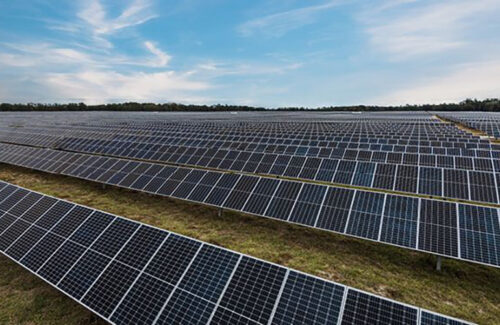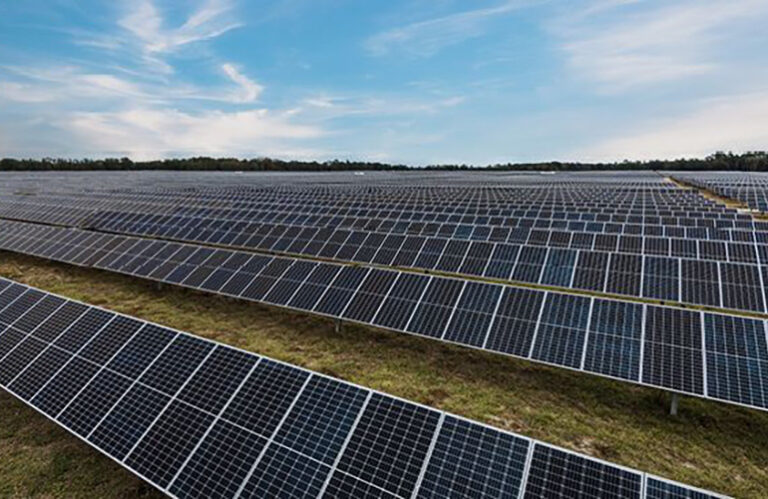A review by the SUN DAY Campaign of data recently released by the Federal Energy Regulatory Commission (FERC) and the U.S. Energy Information Administration (EIA) confirms that 2024 has started with strong solar growth, both in total capacity as in electricity generation. This is expected to continue for at least the next two to three years.

Credit: Duke Energy
In his last “Update energy infrastructure” (with data through January 31, 2024), FERC reports that solar was responsible for 2,527 GW of new generation capacity in the first month of this year – or 87.3% of total new generation capacity. That’s the second-highest monthly total ever reported for solar, behind only the previous month when 4,979 GW was added. Renewable sources accounted for 98.3% of capacity additions in January.
The new solar and wind energy brought the total available installed generating capacity from renewable energy sources (including hydro, biomass and geothermal) to 376.33 GW or 29.17% of all U.S. generating capacity. That is more than the installed capacity of coal (207.15 GW) or nuclear energy (103.27 GW).
Installed utility-scale solar capacity (104.61 GW) alone now exceeds not only that of nuclear power, but also that of hydropower (101.41 GW), and then the additional capacity of small-scale, distributed solar (e.g., rooftop systems) not yet included. good for more than 30% of all solar energy.
FERC suggests that utility-scale solar capacity should also exceed wind energy within the next two to three years. Between February 2024 and January 2027, FERC expects net “high probability” solar additions (including system retirements) to total 85,419 GW. There may be as much as 218,646 GW of new solar energy in the three-year pipeline.
FERC also expects 24,443 GW of net new wind energy plus 561 MW of net new hydro and 400 MW of net new geothermal energy. Coal installed capacity is expected to decline by 22.24 GW, and natural gas and oil will decline by 3.131 GW and 2.051 GW respectively.
With only a “high probability” of additions in early 2027, solar power could account for 13.83% of total available installed generation capacity, while wind power would be 12.79%. Taken together, all renewables would account for 35.45% of the total – approaching natural gas at 40.88% and surpassing coal at 13.45%, nuclear at 7.60% and oil at 2.48% .
In his latest monthly magazine “Electricity monthlyIn the report (with data through January 31, 2024), the EIA stated that the combination of utility and small-scale solar energy increased by 20.5% compared to the first month of last year. As a result, solar’s share of total U.S. electricity generation rose to 3.8% in January 2024, up from 3.4% a year earlier. Electricity generation from a mix of renewable energy sources, including small-scale solar, still outperformed coal by 0.7% and exceeded nuclear power by 10.2%. Despite the lower renewable energy figures for January, EIA still expects significant growth in electricity generation from renewable energy sources this year and next.
In his last “Short-term energy prospects”, EIA projects that the mix of utility-scale renewables will increase their share of total US electricity generation from 21.1% in 2023 to 23.2% in 2024, and then to 25.2% in 2025. solar energy would increase by 76.1% between 2023 and 2025. while electricity generation from wind would increase by 8.9%. Solar and wind energy generation capacities would grow by similar amounts. EIA also expects electric production from hydropower, geothermal energy and biomass to recover this year.
“Solar energy’s rapid growth in both capacity expansions and electricity generation shows no signs of stopping or slowing down,” said Ken Bossong, executive director of the SUN DAY Campaign. “Despite a slow start in January, the mix of all renewables appears poised to continue expanding its share of U.S. electricity generation and generation capacity this year and beyond.”
News item from the SUN DAY campaign


